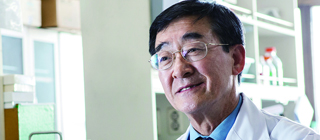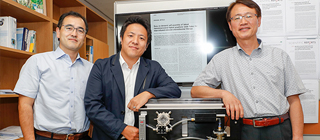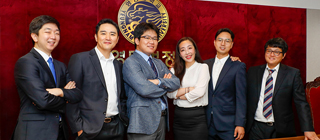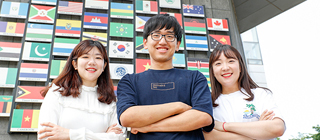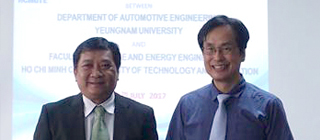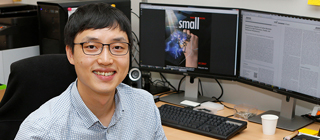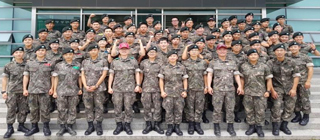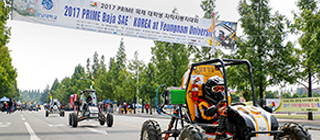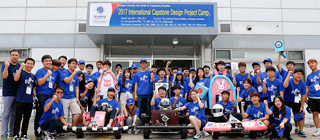-
Chair Professor Jang Hyun-wook (College of Pharmacy) becomes first to explain the allergy suppression mechanism of the longevity gene ‘Sirt1’ Published on online version of Nature's sister journal ‘Scientific Report’ [August 8, 2017] YU Chair Professor Jang Hyun-wook (College of Pharmacy) became the first to explain that the 'Sirt1' gene, which is also known as the longevity gene, suppresses allergic reactions. In 2013 and 2014, Professor Jang scientifically revealed that by artificially activating 'AMPK (AMP-activated protein kinase)', which is a sensor protein to maintain the homeostasis of body energy, it is possible to not only treat metabolism-related diseases such as type 2 diabetes, but also allergy-related diseases as well. The research results at the time received huge attention from academic circles in that is provided the cornerstone for developing new drugs that can treat metabolism-related diseases and allergy-related diseases simultaneously. Upon continuously conducting allergic reaction adjustment research through the interaction of proteins within cells, Professor Jang confirmed through his research that 'Sirt1' suppresses allergic reactions. 'Sirt1' is a protein that detects changes in bio energy like 'AMPK' and it is an enzyme with deacetylation activation. 'Sirt1' is known to have effects for extending longevity by suppressing the death of old cells. Its suppression of calories reduce the risk of chronic diseases, and it is known to be one of the best ways to prolong life. Its effects have been proven time and again in various life forms through scientific experiments. The core adjusting factor for this is the 'Sirt1' gene. Professor Jang said, "'Mast cell', which is a key cell that causes allergic reactions, suppresses the activation of obesity cells by having 'Sirt1' form a compound with 'LKB1' and 'AMPK' when there are no antigen-antibody stimulation. However, dissociation occurs in this compound when stimulated, and instead, the dephosphorylation enzyme 'PTP1B' forms a compound with 'Syk kinase' to generate mediators that cause allergies to promote allergic reactions, which was confirmed through this research." He also added, "Through this process, it was confirmed for the first time through cell and animal tests that 'Sirt1' and 'PTP1B' can adjust allergic reactions through mutual reverse action." The results of this study are significant in that it provided important base data that pharmacologically 'Sirt1 activation' or 'PTP1B suppression' can be used for developing new medicine that improve not only allergic diseases but also metabolism-related diseases. Professor Jang announced his future research plans stating, "In addition to the Sirt1, which is the adjusting protein of AMPK, I will continue research on allergic reaction adjustment mechanism research through interaction with new adjusting proteins and research on finding ‘Sirt1-LKB1-AMPK’ route activators." This study was carried out as the 'basic research lab support project (BRL)' supported by the Ministry of Science, ICT and Future Planning and the National Research Foundation. The research results were published in the sister journal of Nature, 'Scientific Reports' online version (July 25, 2017).
-
Three bachelors/masters at Professor Koh Young-gun's research lab Swept '1st, 2nd and 3rd place in the poster awards' at the 'APSMR-2017' international academic conference in the materials sector Research power synergy effects through sharing and collaboration in research among undergraduate and graduate school students [August 16, 2017] <YU School of Materials Science and Engineering students who swept first, second and third place in the best poster awards at the ‘2017 APSMR’> (From left to right: Min Ji-hoon, Mahendradhany, Joo Yong-hwan) YU students swept the thesis awards at a recently opened international academic conference in the materials sector. At the '2017 APSMR (Asia Pacific Society for Materials Research)' held from July 27 to 30, YU School of Materials Science and Engineering undergraduate and graduate school students under the YU School of Materials Science and Engineering Professor Koh Young-gun (41) research lab took home first, second and third places in the best poster awards section. It is very rare for students from the same research lab to sweep first, second and third places in a globally acclaimed international academic conference. This shows that the research prowess of the YU School of Materials Science and Engineering is at a world-class level. At this international academic conference, over 200 researchers from Japan, China, Taiwan, etc. participated to present 120 research results. Mahendradhany Agasty (24, second term of master's degree program) enrolled at the YU Graduate School of Materials Science and Engineering) took first place, followed by Min Ji-hoon (26, first term of master's degree program) for second, and Joo Yong-hwan (25) who is currently a senior for third place. They presented the latest research results for 'giga steel heat treating technologies', 'bio-activating surface treating technologies', and 'light metal plastic working technologies'. The research results were published in the internationally respected academic journals 'Scientific Reports;, Physical Chemistry Chemical Physics, and Langmuir. Advising Professor Koh Young-gun said, "The awards received were achieved based on the materials application technologies of heat treating, surface treating and plastic working, which is the backbone for the competitiveness of next-generation automobile materials industries." He added, "The technologies are highly applicable for the automobile materials industry, which is a key industry in the region, and can thus contribute in creating high values through materials innovations." Min Ji-hoon, who was awarded at this conference, also took first place in the poster session of the 'IPMC 2016 (International Process Metallurgy Conference 2016)', which is an international academic conference in the metals field held in Bandung, Indonesia last year while he was a senior as an undergraduate. 'IPMC' is an event where master's and PhD-level researchers from around the world present their research results, and Mr. Min thus received huge attention after taking first place as an undergraduate. Min Ji-hoon said, "Our research lab's culture is one of cooperating and sharing research from undergraduate levels to graduate levels. Focusing on research with our professor and graduate school students ever since my undergraduate school years led to improved research capacities and great outcomes." <School of Materials Science and Engineering Professor Koh Young-gun (fourth from top left) research lab students> Meanwhile, Professor Koh's research team has been cultivating award-winners of various international academic conferences such as the poster awards at 'Green 2015' in Taiwan, poster session award at the 'IPMC 2016' held in Indonesia, and the outstanding poster presentation award at the 'Korean Institute of Metals and Materials' in the past two years.
-
Professors Byun Jung-hoon (Mechanical Engineering)-Kim Jong-oh and Yong Cheol-soon (Pharmacology) reaps outcome of inter-disciplinary convergence research First to develop 'aerosol continuous process', which is a new technology that can be applied to the manufacturing of multi-functional nan-drugs Published in the latest issue of Nature's sister journal 'NPG Asia Materials' [August 17, 2017] <YU research team that developed new technologies for manufacturing drugs through inter-disciplinary (mechanical engineering-pharmacology) integrated research> (From left to right: College of Pharmacy Professor Kim Jong-oh, School of Mechanical Engineering Byun Jung-hoon, College of Pharmacy Yong Cheol-soon, bottom - aerosol continuous process device) YU is receiving attention from academic circles by developing new drug manufacturing technologies through inter-disciplinary (mechanical engineering-pharmacology) integrated research. YU School of Mechanical Engineering Professor Byun Jung-hoon (38) and College of Pharmacy Professors Kim Jong-oh (42) and Yong Cheol-soon (61) conducted collaborative research and became the first to develop the continue process of aerosol (small solid or liquid particles suspended in the air) to manufacture nano-drugs in an on-demand method (manufacturing necessary materials upon the need of users). The YU research team presented the research results of using the developed aerosol continuous process to manufacture nano-drugs (hybrid nano graphene oxide) needed for near infrared ray-induced heated chemotherapy for effective cancer treatment. The research team explained, "The developed technology is a new platform technology that can be applied in a wide range of various multi-functional nano-drug manufacturing," and added, "It can be used as an alternative to the existing complex liquid chemical process, and therefore, it can be applied as a new process technology in the pharmaceutical industry, and furthermore, be applied for customized treatment based on the on-demand method." The research results were published in the latest edition (August 4, 2017) of the world-acclaimed academic journal <NPG Asia Materials> (Impact factor (IF) 9.157) under the title 'Easy on-demand self-assembly of lateral nanodimensional hybrid graphene oxide flakes for near-infrared-induced chemothermal therapy’. Professor Byun Jung-hoon said, "The achievement of this study was the development of platform technologies that can create new additional values for the industry as a joint research combining mechanical engineering and pharmacology." He added, "We are currently concentrating on cooperative research with research teams in the pharmacology sector in order to provide the cornerstone for research and to create values through various bio-medical applications of aerosol. In addition to collaborative research within Korea, we are also engaged in international joint research with the US, Germany and others."
-
Praised for identifying the point of the controversy and high comprehension level and rational defense for the logic of both sides Kang Chang-oh (9th class) won MVP with the best defense plead "I wish to realize legalism and manifest national interests as an attorney" [August 21, 2017] <'Wonyung Muae' team of YU Law School that won the grand prize at the '2nd Mock Administrative Court Contest> (From left to right: Jang Jae-ik, Kang Chang-oh, Jung Gi-yeon, Ji Ja-ram, Jin Hyeong-wook, Baek Chang-ho) The YU Law School (Dean Kim Chang-hee) won the grand prize at the recently held mock administrative court contest. The winning team was the 'Wonyung Muae' team comprised of first-year law school students of the 9th class - Kang Chang-oh (41), Baek Chang-ho (37), Jung Gi-yeon (34), Jang Jae-ik (31), Jin Hyeong-wook (33), and Ji Ja-ram (31). Kang Chang-oh also received the MVP award given to the most outstanding participant in the contest. This was the second time that this contest was held and it was hosted by the Anti-Corruption and Civil Rights Commission and co-sponsored by the Korean Bar Association, Korea Legal Aid Corporation, Korean Association of Law Schools, and the Law Times. In this contest, which was comprised of preliminary reviews of the trial outline and the main mock administrative court contest, a total of 112 people from 16 teams from 13 law schools around the nation competed. After preliminary reviews, a total of eight teams from seven law schools including YU, Korea University, Seoul National University and Sungkyunkwan University competed in the final contest. The theme of the final contest held at the courtroom of the Sejong Central Administrative Judgment Commission on the 20th of last month was the 'Appeal to Retract Suspension of Doctor Licenses'. The participants randomly picked to defend the 'consulting' team to accept that appeal of the claimant to support them and the 'dismissal team' that judged the administrative disposition to be lawful and feasible. The two sides debated fiercely over the issue. The YU team made their defense for 'dismissal' in both trials against other teams. All of the team members received good reviews from judges due to their high level of comprehension on the issues without being geared too much to one side, as well as the logic for both sides, and made their defense in a rational manner. In particular, the YU Law School stood out even more as they participated with the least number of team members at six people. The team members said, "It helped a lot to not lean towards any single logic of consulting and dismissal, while being sufficiently prepared for the issue and taking on a rational approach for both logics." The added, "All of the team members had deep understanding for the legal principles for both dismissal and consulting, and we changed roles and held numerous rehearsals, making it possible for us to react logically regardless of whether we were on the side of dismissal or consulting during the contest." Kang Chang-oh, who won the MVP at this contest said, "During the contest, I realized that there is a big difference in writing what I learned in textbooks with expressing it in words by applying it in the field. During the process of making the defense by applying it in the field, I thought about carefully the positions of the opposing sides and made my approach carefully, making it possible to perceive the issue with a balanced and rational perspective without leaning too much to any single side." He added, "With this award that I did not expect, I have become a lot more confident as well. I believe that this short experience will be a valuable asset for me in the future as a lawyer." They said, "While we are still lacking in skills as future lawyers, Dean Kim Chang-hee and Former Dean Keum Tae-hwan, as well as the other law school professors' advice and encouragement were huge help. In particular, the professors of administrative law helped us with writing our paper and preparing our defense, and their help is what led us to receive this award." They added, "Our team name 'Wonyung Muae' is a Buddhist terminology and it means 'coming together to make harmony'. While we expressed opinions from different angles and made legal arguments in court, we would like to contribute in creating harmony with the common goal of realizing legalism and promoting national interests."
-
Selected 29 students from 16 universities in Korea and abroad such as New York University to be dispatched to the UN Headquarters in New York in August Three YU students selected, thus receiving recognition for global capacities "Want to discuss international issues with experts and working-level staff of different countries to gain experience in international activities" [July 25, 2017] <YU student selected as Korean college student representatives to the UN Headquarters in New York> (from left to right: Yoon Soo-hyun, Jung Si-young, Heo Dong-hwa) Three YU students will be dispatched to the UN headquarters as Korea college student representatives. The World Federation of United Nations Associations selected the 'UN Headquarters Korean College Student Representatives' and will dispatch them to the UN Headquarters from August 21 to 25. Three YU students were included in the 'UN Headquarters Korean College Student Representatives'. The YU students are Jung Si-young (25, College of Pharmacy, junior), Yoon Soo-hyun (24, Department of Cultural Anthropology, senior), and Heo Dong-hwa (23, Department of Saemaul Studies and International Development). A total of 29 college students from 16 universities in Korea and abroad such as New York University, Columbia University, Furman University, Korea University, Yonsei University and Hanyang University were selected. Heo Dong-hwa, who majors in Saemaul Studies and International Development said, "I want to utilize my major and after graduating, work with a non-profit institute or international organization engaged in ODA. I am very excited about this opportunity to go to the UN Headquarters." He added, "I have been interested in the health and medical field ever since I was in high school in the United States. During my visit to the UN Headquarters, I hope to speak with many hands-on workers on the duties and assignments of various fields. Furthermore, I want to come back with a lot of information such as whether it fits the career path I am looking for." The representatives are scheduled to group up into teams based on themes such as urban development and sustainable development to collect data and make presentations, and share their opinions with local hands-on workers at the UN Headquarters. Yoon Soo-hyun stated, "I visited the UN Headquarters during my six month language program in New York. I am preparing a lot despite the fact that it will be short because this is not just a trip or visit, but I am an official representative." She added, "As this is an opportunity to actually experience what happens at international organizations while meeting with people from around the world including UN workers, I will make a lot of preparations and learn as much as possible." The representatives will learn and experience 'UN's various and specialized structure', 'major agendas', and 'overall understanding and critical thinking on multi-party decision-making procedures' under the theme of 'UN Sustainable Development Goals' that will be the development index of the entire world by 2030, and are anticipated to train their capacities to gain a foothold for international activities. Jung Si-young, who is also preparing for as a member of the representatives, said, "I applied to join the representatives because I wanted to experience in person what exactly the UN, which is a highly known international organization, does. I feel that my English is not as good as the rest of the representatives so I am concentrating on studying English for now." She added, "I have high expectations as the majors of the other students are diverse and because I will be able to meet with workers from various countries at the UN Headquarters in New York. I hope that I will be able to speak about various international issues with them, hold discussions, and learn and experience the perspectives of various people."
-
Pledged to gather capacities of the two institutes to improve education, research and academic exchange for departments related to automobiles Goal to foster talented human resources for the future automobile engineering sector [July 21, 2017] The YU Department of Automotive Engineering and Vietnam's Ho Chi Minh City University of Technology and Education Department of Automobile and Energy Engineering agreed to work together to foster talented human resources in the automobile engineering sector. On the 20th, YU Department of Automotive Engineering Dean Hwang Pyeong (right on photo) visited the HCMC University of Technology and Education in Vietnam and met with the university president Do Van Dzung and Department of Automobile and Energy Engineering Huynh Phuoc Son (right on photo) to sign an MOU. With this agreement, the two universities agreed to work together to seek for cooperation plans according to joint research, cyber lectures, the Asian University Network's engineering certification program, and the Accreditation Board for Engineering Education of Korea (ABEEK) program, for student and professor exchange and exchange systems for fostering human resources in the future automobile engineering sector. YU Department of Automotive Engineering Dean Hwang Pyeong said, "Professors who earned their degrees at YU and gained technological and research capacities in Korea are currently fostering students at the HCMC University of Technology and Education, and it is therefore expected that there will be synergy effects for fostering specialists in automobile engineering." There are currently three professors who earned their PhDs at the YU Graduate School of Mechanical Engineering at HCMC University of Technology and Education. Two of them are vice-deans and one is the dean, thus showing that they hold key positions at this university. They are currently passing on their knowledge and experience in engineering that they picked up at YU and Korea for young talents in Vietnam. HCMC University of Technology and Education President Do Van Dzung who was also present at the MOU signing ceremony said, "I hope that in addition to cooperation and exchange in the automobile engineering sector, we can have a more comprehensive MOU for various other academic fields." The HCMC University of Technology and Education was founded in 1962 and is a public university with 20,000 students. Thanks to the development of Vietnam and its rapid growth, the employment rate of graduating students is approximately 98%, and its educational performance has thus been recognized. The main facilities of the university were built with the support of Australia, Japan, Germany, Australia, etc., and it is currently receiving support from 'USAid', which is an American government institute in charge of foreign aid of the US. At the MOU signing ceremony held at the HCMC University of Technology and Education in Vietnam, YU School of Mechanical Engineering Professor Kim Byung-il explained the 'Development of the Korean Automobile Industry and NVH (Noise, Vibration, Harshness) Research', and received huge responses. Vietnamese students asked many questions about Korea's automobile industry and technologies, and about studying at YU.
-
Developed 'high performance flexible/transparent patch-type optical sensor' using carbon nano-materials and organic matter Published as cover paper for the latest issue of 'Small', a global academic journal in the nano-material sector Expected to be used as an 'advanced electronic device for the health and cosmetic sector' that can be attached to the human body [August 7, 2017] YU School of Mechanical Engineering Professor Choi Jung-wook (33, photo) is receiving attention from the academic circles for developing a high performance patch-type optical sensor. Optical sensors are elements that convert light into electric signals. It is used for measuring physical quantity such as the wavelengths and intensity of light, but also in a variety of other fields such as information processing, optical communication, and the medical field. There has recently been many studies being conducted to develop flexible optical sensors with the development of flexible electronic devices. However, electrodes, which are major elements that comprise sensors, are comprised of opaque or easily broken materials such as metals or indium oxides and therefore have limitations in being used for actual flexible sensors. The research team used carbon nano-materials and organic materials that react sensitively to light to develop patch-type optical sensors with excellent flexibility, elasticity and transparency. The results of this study, which was carried out as a joint research with the Yonsei University Professor Kim Jong-baek's team was published as the cover paper (see cover below) of the latest issue (Jul 19, 2017) of the world-acclaimed academic journal <Small> (impact factor (IF) 8.643). Professor Choi said, "As a substance in charge of photosynthesis for plants and 'carbon nano-materials', which is a new material that has recently received huge attention, this is the first case to develop highly sensitive optical sensors that are transparent and elastic by creating an integrated structure of porphyrin that generates electric signals by reacting to light." The research team created a transparent and elastic optical sensor that uses graphene as the electrodes in carbon nanotube channels that can act as semiconductors. Carbon nanotubes and graphene are substances made up only of carbon. In addition to the very small size at nano-meter units and its excellent intensity, it has outstanding physical and chemical properties, and therefore, research on developing highly flexible electronic devices using these are actively under way. However, carbon nano-materials have extremely low light reaction, making it difficult for use as an optical sensor. Professor Choi said, "Porphyrin was functionally treated on the carbon nanotube to overcome the low light reactivity of carbon nano-materials. Accordingly, it was possible to change the electric characteristics of carbon nanotubes and detect the intensity of light. The sensors developed here are comprised of only elements that are transparent and has very small changes in properties due to mechanical changes, and it was thus confirmed that it was possible to measure light without reduced performance even after repeated bending." Professor Choi said, "It is expected that the development of patch-type wearable devices that are attached on the human body will become more active in the near future. The optical sensor developed by us is very thin and transparent. The weight and volume was reduced greatly and so it is easy to attach on the skin." He added, "It can not only be used as an advanced electronic device in the health and cosmetic sector, but will also be able to bring forward the distribution of practical elements based on carbon nano materials." Professor Choi earned his PhD in mechanical engineering at Yonsei University and completed his post-doctorates at Purdue University in the United States and began serving as a professor at YU from 2016. His main field of research is the micro electro-mechanical systems and he mainly focuses on research in ultra-small energy conversion elements and wearable electronic devices using nano-materials, as well as sensors and nano-compound materials.
-
56 in first basic training for the summer of 2017, 3rd place in the 110 ROTCs nationwide Since the establishment of the YU ROTC in 1968, a total of 5,147 officers from 56 classes Opened Department of Military Studies through an MOU with the Army in 2011, offering four year scholarship and guarantee to become officer [August 1, 2017] <YU ROTC cadets participating in the 1st summer basic training of 2017> The YU ROTC (Director Colonel Lee Joo-hwan) is exhibiting outstanding capacities in the ROTC cadet summer basic training that began during the summer break. Basic training is a military education received for a total of 12 weeks (2 weeks in the winter and 2 weeks in the summer for juniors and seniors) where ROTC cadets enter the ROTC school during summer and winter breaks based on the knowledge they learned in school. In the 1st summer basic training of 2017 conducted at the ROTC School located in Gwesan, Chungbuk with the start of summer break on June 26, a total of 56 ROTC cadets including Cadet Song Geun-seong (22, Business Administration, senior) joined. At the first training up until July 21, the YU ROTC was selected as the 'overall best ROTC'. 'Best overall ROTC' is given to the top three corps among the 110 ROTCs around the nation (52 colonel-level ROTC). Together with YU, Seoul National University and Ulsan National University were also selected as overall best ROTCs. YU President Sur Gil-soo said, "I believe that their diligence in their studies during the semester led to such great outcomes at the basic training. I am proud as the president of the university." He added, "I trust that as the cadets did not rest during vacation and worked harder than everyone else, they will become excellent officers who lead by example and exhibit patriotism after they are commissioned." The YU ROTC also had award winners in basic military education courses per service sector such as the Infantry School among the cadets that were commissioned this year. Among the 62 cadets of the 55th YU class commissioned in 2017, seven won awards at the Infantry School, Armor School and Field Artillery School, thus exhibiting their exceptional combat readiness. In 1968, YU integrated and launched the '121st ROTC'. A total of 5,147 from 56 classes were commissioned as officers, and there are currently 114 people (including six female cadets) enrolled as ROTC cadets. In 2010, it was selected as the pilot school for female ROTC and has up until now graduated 27 female officers. In March 2011, it opened the first Department of Military Studies in the Daegu-Gyeongbuk region through an MOU with the Army. The quota per grade is 40 and all students are given military scholarships from the Army and are exempted for four years of tuition. They are guaranteed to be commissioned as officers upon graduation.
-
‘2017 PRIME Baja SAE Korea' Ends in Huge Success From 13th to 15 at the YU Gyeongsan Campus, 34 teams from 24 universities of Korea and abroad competed YU's 'YUSAE 16' team takes home overall best, first place for second straight year [Jul 15, 2017] <'2017 PRIME Baja SAE Korea' Car Parade> The PRIME Baja SAE KOREA at Yeungnam University 2017 completed a passionate three day schedule and closed its curtains on the 15th. This year marks the 22nd anniversary and was joined by three universities from abroad including Rajamangala University of Technology Thanyaburi and Chulalongkorn University of Thailand, and Singapore Polytechnic, as well as Chungnam National University Korea University of Technology and Education, Korea Aerospace University, and Hongik University for a total of 34 teams from 24 universities from Korea and other parts of the world to take part in a passion-filled race. <'YUSAE 16' team that won best overall> Lee Gyu-ik (21), a sophomore at Keimyung University Department of Mechanics and Automobile Engineering, who participated in this event as the driver for the 'Speeding' team, said, "This is the third time I am participating in this event following 2014 and 2015. I've taken part in various self-made automobile competitions not only at YU, but also in the US and in Gunsan. However, Baja SAE Korea held at YU has the best off-road track. It is a shame that compared to the excellent infrastructure, there are not that many participating teams. I hope that next year more students will participate and create a festival for everyone." He added, "I've finished my military service so I am now starting to study my major in earnest as a sophomore and I am highly interested in the automobile design field. My experience participating in self-made automobile contests for several years will help me greatly in studying my major." At this year's competition, the YU 'YUSAE 16' team took the overall best award and received the Minister of Trade, Industry and Energy Award, a trophy, winner's flag and a cash prize of 3 million won. 'YUSAE 16', which is a team comprised of students in the YU self-made automobile club 'YUSAE', won the event for two straight years now once again demonstrating that it is the top in self-made automobile competitions. Second place overall went to the ‘S.E.C-TU’ team of Tongmyung University, and third place went to the 'Dynamics' team of Hannam University. <Participants preparing for the static test> At 9 a.m. on the 13th, which was the first day of the event, the participants completed their registrations and then proceeded with the static test to check the creativity of the automobile design, structural safety, driver convenience, ease of maintenance, and potential for mass production, and also held basic braking tests and rule meetings late into the evening. <Dynamic test> In the morning of the 14th, with the attendance of all of the participating teams, volunteers, sponsors, etc., the official opening ceremony was held and the participating teams held a car parade at the main field and roads near the school. In the afternoon, dynamic tests on acceleration, top speed, and rock climbing were held. On the last day of the 15th, the durability test, which is the highlight of the event, was held at a 3.5km long off-road track at the mountain behind the YU water purification center. <'Durability test', the highlight of the competition> YU Department of Automotive Engineering Professor Hwang Pyeong, who was the chairperson of the event, said, "I am convinced that the students will have experienced and felt many things while running around in the hot weather and taking part in the automobile design, production and operation." He added, "Regardless of the results and rankings, the theories they learned in the classroom and the on-site experience through this contest will be valuable assets to students." The 'Baja SAE Korea' is a contest in which college students demonstrate automobiles that they made and first began in 1996. In 2001, it received approval from the US SAE for the first time in Korea and has become an international event and is being held annually at YU. The results are announced to the entire world through the official homepage of SAE (www.sae.org) and publications.
-
'International Capstone Design Project Camp 2017' hosted by the YU Engineering Education Hub Center Engineering students from three countries such as Singapore, Thailand and Korea work together for creative comprehensive design for international cooperation [Jul 14, 2017] <Participants of the International Capstone Design Project Camp 2017> The 'International Capstone Design Project Camp 2017' in which college students from Korea, Singapore and Thailand gathered to make an actual self-driving electric vehicle was held at YU. YU hosted the 'International Capstone Design Project Camp' in 2013 for the first time in Korea and has been hosting the event ever since celebrating the fifth year this time around. 'Capstone design', which means 'creative comprehensive design' aims at fostering engineers with practical abilities and creativity. This is an engineering education program that allows students to design, produce and evaluate products needed in industries based on the knowledge they acquired in their respective fields in order to enhance their creativity, practical abilities, teamwork, and leadership. This camp, which was held from the 10th by the YU Engineering Education Hub Center (Director Song Dong-joo) will be held for six days until the 15th. At this camp, 64 students from 16 universities including three foreign universities such as Rajamangala University of Technology Thanyaburi and Chulalongkorn University of Thailand, and Singapore Polytechnic participated. The participants were mixed by university and major into four teams to complete their assignment. The theme of this camp was 'self-driving electric automobiles'. Self-driving electric automobiles use existing electric motors and combine it with a self-driving system using Arduino sensors, etc. Each team will listen to lectures related to self-driving electric automobiles and then design and produce an actual vehicle. The teams were made up in advance before the camp started to share opinions and decide on their concept in order to perfect their work during the short period of the camp. Kim Jin-woo (23, Halla University) who was the team leader of C Team comprised of students from Thailand, Singapore, Halla University, Hongik University and Keimyung University said, "This was a valuable experience as we were able to apply the theories that we learned in class and utilize our teamwork to produce a self-driving electric vehicle, which has become one of the biggest issues in the automobile industry." He added, "I believe that the opportunity of joining teams with students from different countries and regions and who have different majors to approach the task from various viewpoints will be very helpful in my future studies. I really hope to be able to participate in this camp again next year." Participating students listened to theoretical lectures every morning at 9 a.m. and then went on to the workshop, while also building their own vehicle in a very tight schedule. On the morning of the 14th, which is the fifth day of the camp, the students held a car parade with their self-made self-driving electric vehicles at the 'Baja SAE Korea 2017' opening ceremony. YU Engineering Education Hub Center Director Song Dong-joo (Professor of mechanical engineering) who supervised this camp said, "This is the fifth year of hosting this camp and the student's levels and abilities are continuously rising. Staying up all night during the camp and working hard on their project will be a great experience for the future of the students." He also stated, "This year, the project integrated self-driving and electric vehicles. I hope that through this camp, the university will be able to cooperate in industry-academic projects with the automobile and IOT industries, which is the main industries of this region."
